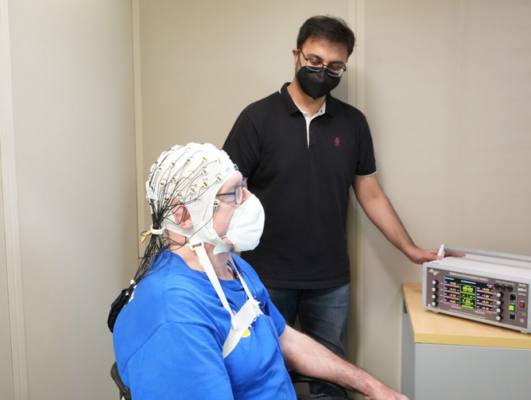September 01, 2022 ✒ Andrew Kantor
Wait, what? “[M]ice respond more to the antidepressant effects of the drug ketamine when administered by men and not by women.” University of Maryland researchers had anecdotal evidence of the men vs. women thing, and, if true, it would skew their mice work. So they decided to study the effect. Mice, they found, preferred the scent of women. In fact, they preferred it so much that being around men increased the mice’s stress levels. That stress activated a brain hormone called corticotropin-releasing factor; CRF, for unknown reasons, makes ketamine work better. Solution: Give the mice CRF with their ketamine. When the researchers had women administer the ketamine along with an injection of CRF, the mice finally responded to ketamine as if they were being treated with an antidepressant. This (probably) isn’t true for humans, but “the brain mechanism underlying their findings could help determine why some people do not respond to ketamine antidepressant therapy.” Apparently, taking a folic acid prescription increases not only your chance of getting Covid-19, but also your chance of dying from it. And not small numbers, either. The study, out of UC Davis and the University of Alabama, found that people taking folic acid (aka B9, aka folate) were “1.5 times more likely to get Covid-19. They were also 2.6 times more likely to die from Covid-19.” Important: This wasn’t people taking a low-level OTC supplement (less than 1 mg a day) — this was about the prescription-level (e.g,. 5 mg) stuff. There’s good news. If those patients also get a prescription for methotrexate, that mitigates the risk. The FDA has approved both Pfizer’s and Moderna’s Omicron-fighting Covid booster vaccines. Next up, a CDC committee and then (presumably) a full CDC approval. “Americans born in 2021 can expect to live for just 76.1 years — the lowest life expectancy has been since 1996,” says the lede from Stat News. Wrong wrong wrong. Yes, the Covid-19 pandemic dropped US life expectancy 2.7 years. But that number does not mean that’s what an individual can expect to live. Grrrr. Life expectancy is an average of a population; a gauge of its overall health — to compare country to country, or 2022 to 1966. But it doesn’t apply to individuals. The Atlanta Braves overall batting average is .253, but that doesn’t mean every Braves player can expect a hit 1/4 of the time. Outliers like Mike Ford (.000) and Alex Dickerson (.121) are like kids who died in childhood, while Chadwick Tromp (one game, .750) is the WWI vet celebrating his 108th birthday. Neither affects what Matt Olsen does at the plate. The takeaway from that new life expectancy number is “Yikes, Covid-19 really did kill a lot of people.” If you don’t get enough niacin, your chance of getting a migraine goes up. And there’s actually a magic number: 21 mg per day. Chinese researchers (looking at data on American adults) found that the results of the niacin/migraine connection follow an L-shaped curve, meaning once you hit that 21.0 mg/day mark, your risk plummets. A protein called lactoferrin, which is in anything made with mammal’s milk, seems to have “astounding antiviral properties,” at least according to researchers at the University of Michigan College of Pharmacy. It turns out that lactoferrin has several different mechanisms of action against SARS-CoV-2, inhibiting the virus from entering cells, moving around within them and replicating. The only problem is getting enough of it and having it stay around, considering the body will just digest it. (“To get enough lactoferrin to have a possible beneficial effect, one would have to drink gallons of milk a day.”) Chewing gum or pills might work, though, and that’s what they’re planning to test. In the meantime, there are always lactoferrin gel capsules — you might even sell them. [Prof. Jonathan] Sexton calculates that about a gram a day, four 250 milligram capsules, should do it. He advises two in the morning and two a night [on an empty stomach]. It may work, it may not, but it certainly won’t hurt. Peanuts can help you lose weight … according to a Texas Tech/University of South Australia study funded by The Peanut Institute. For those of you keeping track, this is at least the third Texas Tech story touting the benefits of peanuts, and funded by the same organization. An Emory University immunologist explains ‘How researchers are zeroing in on the self-targeted immune attacks that may lurk behind long Covid.’Sexist lab mice, milk fights Covid, low niacin makes migraines, and more
Of mice and men
Beware folic acid and Covid
2022 boosters clear hurdle
That is not how life expectancy works
* People in the Middle Ages lived into their 70s and 80s all the time, but high child mortality helped skew the data so the average was 40-whatever.
Niacin and migraine
Eat ice cream, fight Covid
Nuts to you
The Long Read: Fighting Long Covid edition
August 31, 2022 ✒ Andrew Kantor
“Nothing, not a smidge” — that’s how much difference Scottish researchers found there was for people taking their antihypertensives in the morning vs. the evening. “Patients can take their BP medication in either the morning or evening, as the timing makes no difference to cardiovascular outcomes. This is the result and I think it’s definitive.” If you haven’t renewed your GPhA membership yet, it ends today. That’s it — starting tomorrow, you’ll be a former member! Don’t let that happen! You’ll not only lose out on member benefits, but more importantly, you’ll be hurting the profession and Georgia patients who count on GPhA to fight for them. If you haven’t renewed yet, get yourself over to GPhA.org/renew and do it right now! Rapamycin — officially for cancer therapy and after organ transplantations, but also known to increase lifespan … if taken for life. The problem is the side effects; they’re tolerable if the alternative is organ rejection and death, but not so much if you’re just taking it to live longer. But German biologists just learned something new: At least in animals, “brief exposure to rapamycin has the same positive effects as lifelong treatment.” The trick is that the brief exposure needs to happen as early as possible. Giving it to young adult mice for just a few months, for example, protected them through middle-age. Next up: Seeing if there’s a way to get those effects when administered later — those Boomers aren’t getting any younger. Papa Bear was too fat. He got migraines. Mama Bear was too skinny. She got migraines. Baby Bear’s BMI was jusssst right, so Baby had a lower risk for migraine, but spent a lot of time contemplating the “nature vs. nurture” debate. [R]esearchers found that compared with those with normal BMI, participants who were either underweight or had obesity had an increased risk for migraine. This coming Friday will be the last time you can order free at-home Covid-19 tests from Covidtests.gov. As Congress has cut further funding for combatting Covid-19, HHS has decided to save the remaining stockpile of tests for an expected fall surge. “If Congress provides funding, we will expeditiously resume distribution of free tests through covid.gov. Until then, we believe reserving the remaining tests for distribution later this year is the best course.” Eating too much sugar can lead to diabetes, but the reasons for that aren’t entirely clear. A new discovery, though, points its sweet finger at what’s becoming a common culprit: the gut biome. Columbia University microbiologists found that too much sugar killed off segmented filamentous bacteria in the gut. That kind of bacteria happens to help produce Th17 immune cells. And Th17 immune cells “are necessary to prevent metabolic disease, diabetes, and weight gain.” “These immune cells produce molecules that slow down the absorption of ‘bad’ lipids from the intestines and they decrease intestinal inflammation. In other words, they keep the gut healthy and protect the body from absorbing pathogenic lipids.” Does that mean that pre- or probiotics with filamentous bacteria might save the Th17 and stave off diabetes? Perhaps, but you know the mantra: More research is needed. Once again, an answer to the never-ending question: How much alcohol is safe to drink? And today’s answer is … Maybe none? A German research team has found that “Even a single dose of drinking alcohol — ethanol — can permanently alter synapses and mitochondrial movement in the brain’s neurons.” And that, they say “suggest[s] that even a single consumption event can lay the foundation for alcohol addiction.” That might be fearmongering, but to be fair, they found that can happen in fruit flies and mice, so why not humans? “These mechanisms may even be relevant to the observation in humans that the first alcohol intoxication at an early age is a critical risk factor for later alcohol intoxication and the development of alcohol addiction.” There is, apparently, a single protein complex that controls a whole line of metaphorical dominos in humans. If that protein — called PRC2 — doesn’t work correctly, genes stop doing their jobs correctly, eventually leading to the body not producing dopamine and serotonin. And that, say Swedish researchers, leads to the kinds of symptoms typical of Parkinson’s. The big takeaway is that, even if someone’s genes are okay, a problem with a protein that regulates those genes could lead to effects just as bad. The good news, though is that this finding “could open up interesting new possibilities for diagnosis and treatment.” This might be overkill, but if someone suffers from loss-of-control binge-eating disorder, Penn researchers say that wiring a device into their brains can stop the cravings. They found that, just before a binge-crave begins, the brain’s nucleus accumbens starts getting active in a specific way. By using a device approved for treating epilepsy — “surgically placed beneath the scalp, with wires running through the skull to the nucleus accumbens in each hemisphere of the brain” — they were able to interrupt that activity with a bit of high-frequency electrical stimulation. [T]he patients reported sharp reductions in their feelings of loss-of-control, and in the frequencies of their bingeing episodes—each also lost more than 11 pounds. […] There appeared to be no significant adverse side-effects. If someone has end-stage liver disease, there might be an alternative before jumping to a transplant: “growing tiny new livers elsewhere in the patient’s bodies.” A company called LyGenesis is beginning human trials of a technique it developed to grow miniature livers throughout the body, taking up some of the load — “Transforming a patient’s lymph nodes into bioreactors capable of growing functioning ectopic organs.” The process involves injecting healthy liver cells, taken from donated organs, into the recipient’s lymph nodes. There, they multiply and grow into functioning mini versions that can support the work of the remaining cells in the original liver.How diabetes starts, weight and migraines, growing tiny livers, and more
It doesn’t matter when you take BP meds

Did you renew?
A small dose to live forever
Migraines: Size matters
The end (sort of) of free Covid tests
Another diabetes clue
Alcohol, not even once?

Another Parkinson’s clue
Wild medical science
Zapping the cravings
One liver good, many livers better!
August 28, 2022 ✒ Andrew Kantor
Apparently a lot of pharmacists do — that’s what APhA (along with a whole bunch of other organizations*) told White House National Monkeypox Response Coordinator Robert Fenton and his HHS colleagues in a letter, “Request to amend the declaration of a monkeypox Public Health Emergency” (PDF). “To ensure pharmacists are able to expand patient access as monkeypox testing, vaccine and therapeutic supplies increase, we urge you to proactively authorize pharmacists to order and administer monkeypox testing, vaccines and therapeutics.” At some point pharmacists will simply be included in these efforts by default, and we won’t need to write letters every time there’s a need to get shots in arms. Till then, thank you, APhA et al. (Well let him out! Ha!) But seriously, here’s the deal: LeadershipGPhA is how GPhA trains future pharmacy leaders — you know, the ones you read about who set the tone for the profession in Georgia. The academy is October 21 – 23 at the Westin Perimeter North in Sandy Springs, and everything is provided free to the eight candidates chosen. You are invited to apply if you: If you want to help lead the profession, click here for details of LeadershipGPhA and apply today! Drug discovery ain’t cheap, and those later-stage human trials are especially pricey, what with people wanting to be paid and all. Animal tests are good, but … I mean, look at their little faces! What’s coming is a whole new level of computer testing — in vitro and in situ, meet in silico. Artificial intelligence is getting better, and getting better fast … to the point that computers can look at drugs (and humans) at the molecular level and tell us, “Yeah, this looks like it’ll work.” Research has reached a point where computational power and understanding of biology allow highly specific predictions to be made on how a medicine will affect the human body. Fun fact: AI is so good now that humans don’t teach computers anymore. We just build the teachers and no longer know how they do their jobs, just that their “students” seem to know what they’re doing. Creepy, huh? (Nifty video on the subject.) Pro tip: If someone is about to give you health information, and they start with, “I saw on TikTok…,” feel free to laugh before they finish. Unfortunately, teens don’t get the joke. A new study out of Slovakia’s Comenius University found that “41% of teenagers can’t tell the difference between true and fake online health messages.” There are often “cues” in fake info: superlatives (“This will make you 400% better!), clickbait (“The most dangerous snack you’re eating”), grammar mistakes (“Bestly foodstuffs for you’re acnes”), authority appeal (“98% of doctors take this supplement”), and bold typeface. The only one that was a red flag for teens? Clickbait. “As adolescents are frequent users of the internet, we usually expect that they already know how to approach and appraise online information, but the opposite seems to be true.” Trust me, I’m in “influencer.” Another reason to get the MMR vaccine (besides making sure your kids don’t contract a horrific disease): It can reduce their risk of inflammatory bowel disease. A study out of the University of Michigan found that “receiving at least one MMR vaccine dose was associated with a 21% lower risk of developing IBD compared with not getting vaccinated.” (It may also lower risk of Crohn’s disease and ulcerative colitis, but those results weren’t statistically significant.) Add a safety feature to a car and it also adds a bit of unsafe behavior. (Someone in an SUV with antilock brakes and 22 airbags won’t drive as carefully as someone in a ’63 Corvair.) That’s why, when HIV pre-exposure prophylaxis hit the scene, people worried it would increase risky sexual behavior, and thus lead to an increase in bacterial STIs. Forget guessing — the Aussies decided to find out. PrEP went nationwide there in January 2016, so it was easy to crunch the data. The result: After a brief uptick in STIs, the numbers dropped, and — and this is the big takeaway — have remained lower than before PrEP’s introduction … except for syphilis, which increased slightly possibly due to “changes in sexual networks following PrEP implementation.” When a state legalizes recreational marijuana, more people use it — that’s Captain Obvious territory. But researchers at the universities of Minnesota and Colorado teased out some interesting detail when looking at longer-term trends. They did it by looking at twins. From “Clinicians React to Over-the-Counter Birth Control Possibility”: “Accessing contraception over the counter could be a game changer for people who experience common barriers to accessing clinics. For example, this may help people who can’t get an appointment for several months, who don’t have a nearby clinician for care, who can’t get off work or school to attend a clinic appointment, who do not have transportation, who need additional privacy, [or] who prefer to self-manage their contraception.” When a teen has anxiety or depression, it’s one thing to use medication — it’s another to just throw pills at them. But too often, that’s the case. Increasingly, anxious and depressed teens are using multiple, powerful psychiatric drugs, many of them untested in adolescents or for use in tandem.Gullible teens, the faster future of drug discovery, MMR vax bonus, and more
So you want to give the monkeypox vaccine
* AACP, American Association of Psychiatric Pharmacists, ACP, American College of Clinical Pharmacy, Academy of Managed Care Pharmacy, American Society of Consultant Pharmacists, ASHP, Food Industry Association, Hematology/Oncology Pharmacy Association, Society of Infectious Diseases Pharmacists, NASPA, National Association of Specialty Pharmacy, NCPA
Is there a leader in you?
Electric brains do it faster
Teens believe anything

MMR mission creep (in a good way)
It’s okay to be prepared
Interesting pot stats
Quote of the Day
— Melissa Kottke, MD, associate professor in the Department of Gynecology and Obstetrics, Emory UniversityThe Long Read: Teen Polypharm edition
August 27, 2022 ✒ Andrew Kantor
Out of seemingly nowhere, a major announcement from the White House: Data from all publicly funded research will have to be made available to everyone free and immediately, starting Christmas 2025. No more paywalls. No more $1,000 access fees. No more embargos. It’s a huge boost for research not only in the U.S. but around the world. For-profit companies like Elsevier and “non profit” organizations like the American Chemical Society have made millions charging through the nose to access the $80 billion worth of taxpayer-funded research they publish — even those very institutions that did the research. (At least in the case of the ACS they try to justify those fees by claiming to ‘add value’ by editing and formatting the work.) No longer. There have been workarounds, like requesting copies directly from researchers, or using sites like sci-hub, but that can be clunky and ineffective. And what of the publishers? It may not be getting through to them. In response to the directive, Springer Nature said “that funding agencies must increase their financial support for the publications in exchange for the research to be free to the public.” (Hint: There is no “in exchange.” Do what you’re told.) Another gut bacteria story? Yep. How about this: Mice given the Parabacteroides distasonis bacteria in their guts develop type 1diabetes. And humans? While it’s probably unethical to infect people (even grad students) with P. distasonis to see what happens, Boston College biologists looked at records from a European database and found that people whose guts have P. distasonis (especially as infants) have a greater risk of developing type 1 diabetes later in life. In fact, “100 percent of the infants who were eventually diagnosed with type 1 diabetes had signs of P. distasonis in their gut.” What’s going on? This is likely because the microbe produces a peptide similar enough to part of an insulin molecule that it can lead to the production of insulin-targeted antibodies, priming the immune system to launch an attack against insulin and the cells that produce it. Obviously the development of diabetes is complex, but this could be a pretty big step toward understanding it. If you’re head of the company that makes one of the two biggest Covid-19 vaccines, and you and that other vaccine maker are looking forward to profitable booster shots debuting this fall, what might be going through your head? Perhaps, “This is great! We’re both making billions, lives have been saved, and more importantly our shareholders and CEOs sleep on mattresses made of shredded hundred-dollar bills and pillows filled with down passenger pigeons.” Ha! No, no. You sue the other guy, of course. Moderna has filed patent infringement lawsuits in the U.S. and Germany accusing Pfizer and its partner BioNTech of stepping on patents that Moderna says it filed between 2010 and 2016. Artist’s conception A weird brain protein may lead to a treatment for neurodegenerative diseases. It seems that some forms of a protein called aquaporin 4 are created with a tail, thanks to an error called readthrough. Weirdness: Unlike “normal” aquaporin 4, that “long form” version appears in brain cells called astrocytes where it helps clear unwanted proteins out of the brain — proteins like the kinds associated with Parkinson’s and Alzheimer’s. So (thought Washington University researchers), is there a way to get the body to produce more of it? There is. Actually, there are at least two compounds that do the trick — apigenin and sulphaquinoxaline. Great! Next question: Does having more long aquaporin 4 actually clear more waste? Why yes, yes it does. They tested the compoundeds on mice, and found the treated rodents’ brains cleared amyloid beta proteins significantly faster than controls. Now, while sulphaquinoxaline is toxic for humans, apigenin isn’t. In fact, it’s found in chamomile, parsley, onions and other plants. Although the lead researcher “cautions against consuming large amounts of apigenin in an attempt to stave off Alzheimer’s” this is still good (preliminary) news: “There’s a lot of data that says reducing amyloid levels by just 20% to 25% stops amyloid buildup, at least in mice, and the effects we saw were in that ballpark. That tells me that this could be a novel approach to treating Alzheimer’s and other neurodegenerative diseases that involve protein aggregation in the brain.” So what’s been the result of prescription drug monitoring databases? Tracking and limiting patients’ use of pharmacies to fill opioid scripts has worked … sort of. Marketing researchers (!) at the University of Texas examined the national data from 2006 through 2015. Prescription drug monitoring programs, they said, decreased opioid prescriptions by 6.1%. W00t! But “the policy did not reduce deaths due to prescription opioids.” Huh? That’s because “prescription opioids” doesn’t necessarily mean “opioids dispensed by a legitimate pharmacist.” Cut off from their pharmacies, people are going to the streets “to seek out dangerous and illegal alternatives.” And that includes, obviously, heroin — and “heroin-related deaths increased 50.1% under PDMP mandates.” Based on stock photos, all drug dealers wear dark hoodies. You go to sleep, a small device by your bed. When you wake up, a red light is blinking. Oh no — you have Parkinson’s. How do you know? Apparently MIT researchers have found a way (using artificial intelligence, of course) to determine whether someone has the neurological disease by monitoring their breathing patterns while they sleep. “A relationship between Parkinson’s and breathing was noted as early as 1817 […] Some medical studies have shown that respiratory symptoms manifest years before motor symptoms, meaning that breathing attributes could be promising for risk assessment prior to Parkinson’s diagnosis.” If you woke up at 3:00 am wondering, “Is rat lungworm disease really only caused by slugs and snails?” researchers from the universities of Hawai’i and London have your answer: [A]t least 13 species of prawns/shrimp, crabs, flatworms, fish, frogs, toads, lizards, and centipedes have been associated with causing rat lungworm disease in humans. The good news is that rat lungworm disease is mostly confined to the tropics and subtropics, so as long as nothing changes Georgia’s climate, it shouldn’t be an issue. Sweet dreams.Bacteria causing Parkinson’s, research to be freed, Moderna/Pfizer cage match, and more
“Without Delay”: Federally funded research will be free and open
Unexpected diabetes trigger
Annnnnnnnd fight!

A better brain-garbage cleaner
Unintended consequences

Listening for Parkinson’s
Don’t kiss that frog
August 27, 2022 ✒ Andrew Kantor
Pfizer’s Paxlovid antibody pill is the go-to treatment for mild, early-stage Covid-19. It’s great at preventing mild from becoming severe … but only if you’re older, it seems. An Israeli study of more than 100,000 people found that … … Paxlovid reduced hospitalizations among people 65 and older by roughly 75% when given shortly after infection. […] But people between the ages of 40 and 65 saw no measurable benefit, according to the analysis of medical records. Why not? Most likely because it’s only the older, more vulnerable people who need it. Most people have been vaccinated or exposed at this point, which provides at least some level of protection against the strains that are circulating, so Paxlovid is only necessary for those with the highest risk. Take out life’s frustrations on innocent clay disks, eat some awesome barbecue, hang out with friends, drink some beer if you’re so inclined, and shoot things. (Not in that order.) Ready. Aim. Phire! is always a ton of fun, a chance to get outside, hang with colleagues, and shoot things without legal repercussions. All to support the Georgia Pharmacy Foundation. Sporting clays, you ask? It’s like a cross between — oh, forget it. You get a big gun. You shoot flying clay disks. There’s scorekeeping, competition, golf carts, and fully paid insurance premiums. We’ll even throw in a raffle. It’s all on the Big Red Oak Plantation: 2,500 acres of primeval hunting land a lovely drive 60 miles south of Atlanta (map). Come alone and we’ll get you on a team, or bring three friends and you’re all set. Got some money burning a hole in your pocket? A variety of sponsorships are also available. Deets: Friday, September 16 1:00 – 5:30 p.m. India has reported an outbreak of “tomato flu” — a disease named for the red blisters it causes on the people it infects (mostly children under five). Scientists don’t yet know what causes tomato flu, or even if it’s a virus. “Tomato flu could be an after-effect of chikungunya or dengue fever in children rather than a viral infection [… or] a new variant of the viral hand, foot, and mouth disease.” There’s no treatment and it spreads easily, but it’s not life-threatening. Statins can be beneficial in an unexpected way. There’s evidence that they might help protect women from autoimmune disease. UConn nutritional scientists found that women — but not men — taking statins were less likely to have elevated levels of antinuclear antibodies. Why is that important? Because ANAs are “diagnostic and predictive markers of current or future autoimmune disease.” So while statins’ benefits for cardiovascular health are known, the idea that they might protect women from autoimmune diseases is new … and will need more study, of course. The US Preventive Services Task Force now officially recommends statins “for the primary prevention of cardiovascular disease” in people between 40 and 75 who are at risk of cardiovascular disease — i.e., they have dyslipidemia, diabetes, hypertension, or are smokers. Drug makers are charging record-high prices to Americans for the medications they’ve launched in 2022 — the median annual price here for new drugs this year is $257,000, with “Eight of 13 drugs launched in 2022 priced over $200,000 per year.” (Other countries pay less.) In 2021, the median price for new drugs was $180,000; “between 2008 and 2021, U.S. drug launch prices grew 20% annually.” The drug makers say it’s up to insurance companies what people pay out of pocket. Insurance companies, of course, just raise their premiums (or in the case of public programs, just take it from taxpayers). We already know that, in some cases, psilocybin can treat depression. What else can it do? According to NYU medical researchers, it also seems to fight addiction. Two doses of psilocybin […] reduces heavy drinking by 83 percent on average among heavy drinkers when combined with psychotherapy. That last part is important, and it’s been true in every similar study — it’s not the drug, it’s the drug and the therapy. Some more interesting facts from what they say is the first randomized trial to examine these effects: According to data compiled by the Census Bureau, “Around 16 million working-age Americans (those aged 18 to 65) have long Covid today. Of those, 2 to 4 million are out of work due to long Covid.” Perspective: With about 10.6 million unfilled jobs in the U.S., long Covid could potentially account for 15% of the labor shortage. Some kinds of leukemia are triggered when an enzyme called DNMT3A malfunctions, causing bone marrow cells to run amok. Current treatments, like decitabine, are designed to disable DNMT3A. Unfortunately, they also disable a different enzyme (called DNMT1) that’s critical for keeping cells dividing correctly. Result: the off-target toxicity chemo is known for. But now chemists, led by UC Santa Barbara, have found a different tack. They discovered that the problem enzyme, DNMT3A, always forms complexes. So rather than try to disable DNMT3A altogether, they found a way — using existing chemicals called protein-protein inhibitors — to stop it from forming those complexes — i.e., they disabled it without affecting other enzymes. These drugs are more than merely a potential breakthrough in leukemia treatment. They are a completely new class of drugs: protein-protein inhibitors that target a part of the enzyme away from its active site. While those shifty Danes ramp up production to meet demand for the world’s only monkeypox vaccine, they’re now saying that older doses — shipped in the past few years — might still be viable even if they’re technically expired. ‘[T]he decision to use such doses ultimately lies with U.S. regulators.’ The FDA is looking into it and could “potentially requalify a subset of expired doses that meet certain quality specifications.”Here comes tomato flu, how statins help women, when ‘expired’ isn’t expired, and more
When Paxlovid doesn’t work
Golf — with guns (and coming soon)
Click here for more info and to sign up. Now!What comes after monkeypox?
Statins in the news
Benefits for women
An ounce of prevention
Drug makers: “Jump!” Americans: “How high?”
Psychedelics vs alcoholism
Long Covid labor shortage
A new type of chemo
It just so happens that your vaccine here is only mostly expired. There’s a big difference between mostly expired and all expired.

August 25, 2022 ✒ Andrew Kantor
Low HDL cholesterol isn’t good — that we know. But, found Italian researchers, if HDL is too high it can also be a problem. In fact, they found a ‘greater risk for cardiovascular events among men with high and low HDL levels compared with men with medium HDL.” (Medium, in case you’re wondering, is between 40 and 80 mg/dL.) “Our findings indicate that at high levels (i.e., > 80 mg/dL), [HDL’s] protective effect does not appear to hold true and, in fact, may confer an increased risk in male patients with hypertension.” If you have a mouse with advanced-stage mesothelioma tumors, there’s potential good news on the horizon. Rice University and Baylor College of Medicine researchers have created an implantable ‘drug factory’ — tiny beads that can be implanted next to tumors. The beads contain “tens of thousands of cells that are genetically engineered to produce natural interleukin-2 (IL-2)” that’s delivered right to the tumor — like the Mafia might deliver a message. Then, to be extra sure, they included a PD-1 checkpoint inhibitor. So what happened to the tumors? They were eradicated. In two days. Said one researcher, “I’ve not seen these mesothelioma tumors in mice be eradicated, with such efficacy, as we have in this mouse model.” With current Covid-19 vaccines working well it’s time to take them to the next level. One of the latest candidates comes out of Sweden, where researchers have developed “a new generation of corona vaccine.” Its claim to fame: Rather than target just the often-mutated spike protein, theirs — which is DNA-based — contains parts of two other proteins as well, meaning it should work against current and new variants. It works on mice, so they’re preparing a phase-1 human study. When DNA experimenters need to label something, they sometimes use a molecule called EdU. It takes the place of thymidine on a strand of DNA, but it allows a “probe molecule” to be attached. It’s not a big deal; EdU has been around more than a decade. But EdU seems to have a special property, as UNC scientists discovered: Human cells see it as damage and try to repair it. Here’s the cool part: The repair process doesn’t work because it ends up duplicating the EdU, too. That triggers another repair, causing “a runaway process of DNA repair that is eventually fatal to affected cells, including cancer cells.” Hmm, said the scientists. Hmm. The discovery […] points to the possibility of using EdU as the basis for a cancer treatment, given its toxicity and its selectivity for cells that divide fast. Scientists in New Jersey say they’ve developed a new antibiotic to fight drug-resistant gonorrhea. (Bonus: They used the phrase “game-changer”!) What’s different about this one, dubbed JSF-2659, is that it targets two separate molecules in the infection, “making it extra effective at inhibiting the bacteria’s DNA replication.” And because it’s hitting two targets, not only does it kill more bacteria, it makes it a lot harder for the N. gonorrhoeae to develop resistance. Well, at least according to the models. Right now JSF-2659 is still in the lab, but they’re already looking toward human trials. Two artificial sweeteners — saccharin and sucralose — change the composition of the gut biome to the point that it “adversely impacts glucose tolerance […] possibly leading to weight gain and diabetes.” In other words, those sweeteners might reduce your risk of weight gain from sugar, but they balance that by increasing your potential for weight gain from how you process glucose. Notably, say the microbiologists from Johns Hopkins (who worked with Israeli counterparts on the study), unlike previous studies that found similar results — and triggered a tantrum from the food industry — these tests were done on humans. The good news, though: Neither aspartame nor stevia produced those results. (That’s not to say they’re good for you, but they don’t appear to mess with your guts … at least not in this study.) If vapes are outlawed, only outlaws will sell vapes. And, apparently, the FDA won’t do much about it. Stat News explains how “The FDA stands by as the vaping industry flouts its orders”. Low levels of vitamin D can cause all sorts of issues, from susceptibility to infection to a higher risk of “all-cause mortality.” Not to mention rickets. The weird news: Unnecessary testing for vitamin D levels is not very green. Aussie scientists say that in one year they “cost the healthcare system over AUS$87 million and had a carbon footprint of 28,000 to 42,000 kilograms of carbon dioxide equivalent emissions.” If you’re a human, lack of sleep can make you more selfish — it “impairs our basic social conscience, making us withdraw our desire and willingness to help other people.” If you’re a teen, lack of sleep can make you overweight — and “more likely to have a combination of other unhealthy characteristics including excess fat around the middle, elevated blood pressure, and abnormal blood lipid and glucose levels.”Implantable drug factories, gaining weight with sugar substitutes, why not to test for vitamin D, and more
The HDL Goldilocks zone
Implantable tumor-killer
Next-level Covid vaccine
A killer DNA label
Two-pronged gonorrhea antibiotic
When sweet is sour
The Long Read: Law, Schmaw edition
Weird science
Sleep is important
August 24, 2022 ✒ Andrew Kantor
If people around you seem a little more … out of it these days, there might be a good reason. Americans are using more hallucinogens — from 2002 to 2019, usage overall went from 1.7% of the population to 2.2%. Okay, not a huge jump. But among 18–25 year olds it more than quadrupled — from 0.9% to 4.0%. That means, say Columbia University psychiatric epidemiologists, that more than 5.5 million US adults are taking LSD, ecstasy, peyote, Red Devils, shrooms, Fantasia, Special K, ayahuasca, Angel Dust … you get the picture. And, with the potential for hallucinogens to treat depression, you can expect that number to keep rising. q Methadone can save opioid addicts — it can break their addiction. But UGA College of Pharmacy researchers found that “four of the five Georgia counties with the highest opioid overdose death rates don’t have a methadone clinic accessible within a 15-minute drive.” There might be a way to stop food allergies in their tracks, and it’s all about the gut bacteria. Healthy bacteria produce a compound called butyrate, and butyrate can prevent an allergic reaction to food. Ergo, to prevent allergic reactions, make sure people have enough butyrate. The hard way: Give them a fecal transplant with the right bacteria. The other hard way: Give them a butyrate pill. “But butyrate has a very bad smell, like dog poop and rancid butter, and it also tastes bad, so people wouldn’t want to swallow it.” (Indeed.) The (potential) easy way: Create a new delivery system for butyrate*, which is what University of Chicago chemists say they’ve done. The resulting compound goes down easy (or can be injected) and the butyrate is released by digestive juices. Result: “The treatment restored the gut’s protective barrier and microbiome […] and prevented a life-threatening anaphylactic response when they [the mice] were exposed to peanuts.” And it’s not limited to peanuts, they say — it should work for any food allergan. (Standard disclaimer: I take everything out of the American Chemical Society with a grain of salt, but still, this is clearly interesting news, assuming it’s not hype.) We’ve had an inkling for a while that there’s a connection between salt and hypertension, but the details are only now emerging. Cutting to the chase: Researchers at Vanderbilt University have found that a high-salt meal will cause a spike in blood pressure in half of people who have hypertension, and in a quarter of people who don’t. Why? They have a slightly different receptor in some immune cells, and what they have is super-extra-very sensitive to salt. For those people, a large McDonald’s fries can cause a burst of inflammation … and a potential heart attack or stroke. At the the sensitivity can’t just be switched off, but it can be tested for, meaning folks with that salt-sensitive phenotype can switch to bland meals, at least for now. Sugar makes you fat. Fat can make you fat. But you know what else can cause obesity? According to a University of Colorado researcher, too much salt and too little water. What do those have in common? Thirst — they cause dehydration. And dehydration encourages the body to create fructose from both carbs and starch. It also gets the body to produce more vasopressin, which stimulates fat production to store water. Together … well, unless you’re in survival mode, they spell obesity. Naloxone can stop an opioid overdose in its tracks, and it’s available free in some places thanks to government grants, private charities, and good Samaritans. But not everywhere, and that means people die or end up in hospital because they can’t afford to carry it. In fact, found researchers at the Rand Corporation, for people without health insurance, the out-of-pocket cost for a single naloxone prescription hit $250 in 2018. While many states have adopted laws to make it easier to prescribe and dispense naloxone, less attention has focused on potential financial barriers to naloxone access. Reminder: Naloxone does NOT require a prescription in Georgia. (Read more.) If you’re looking for to give grandma or grandpa a scare, leave this article out for them. It seems that weak electrical currents delivered to the brain via the skin — this particular process is called transcranial alternating current stimulation, or tACS — can help fight the effects of memory loss in seniors. By zapping the brain in precise regions with unique frequencies of alternating current “we could improve either short-term or long-term memory separately. And with this intervention across four consecutive days, we could change memory and watch the benefits accumulate.” Are you ready to rewrite your will now, Granddad? Two stories within a few days, and both tout a potential vaccine for RSV — respiratory syncytial virus, which kills more than 100,000 children and sends 3.6 million to the hospital each year. Niversimab, out of the Telethon Kids Institute in Australia: [A] long-lasting monoclonal antibody treatment for babies is likely to be accessible on the market within 12 months, followed closely by the approval of a maternal vaccine given in pregnancy to provide newborns with protection against the virus. CAF-08/RSV, a new protein-based vaccine out of Boston Children’s Hospital: [It protected against a direct challenge with RSV, with no evidence of any harm to the animals. Further studies showed that it induced Th1 cells and CD8+ T cells (also important in inducing cellular immune responses) that specifically recognized RSV, as well as neutralising antibodies. Would you believe that there are pharmacists who are frustrated working with insurance companies and PBMs? Apparently so — and (slowly) some are going cash-only … and their patients like it. As patients struggle with rising prescription drug prices and insurance deductibles, everyone from members of Congress to entrepreneurs like Mark Cuban and small-business owners like [pharmacist Nate] Hux are trying to lower drug costs. By opting out of the insurance system altogether, Hux and other cash pharmacy owners are able to avoid many of the fees and rules that inflate medication prices. Consumers say they are reaping the benefits. Interesting: The pharmacist in the story runs ‘regular’ and cash-only pharmacies next door to each other and ”advises patients which of his two side-by-side pharmacies will be the best place to fill their prescriptions.” “Our job is to drive down costs on behalf of the consumer and those paying the bill for health insurance.” —JC Scott, president, Pharmaceutical Care Management Association. Zapping grandpa’s memory, pharmacies go cash-only, food-allergy breakthrough, and more
Gotta get away
UGA: Methadone hard to get in Georgia
A cure for food allergies?
* You want the science? Fine: “They polymerized butanoyloxyethyl methacrylamide — which has a butyrate group as a side chain — with methacrylic acid or hydroxypropyl methacrylamide. The resulting polymers self-assembled into aggregates, or polymeric micelles, that tucked the butyrate side chains in their core, thus cloaking the compound’s foul smell and taste.””
Salty news
Salt and your blood pressure
Salt and your weight
Naloxone priced out of reach
Shocking seniors

RSV vaccines coming Real Soon Now
The Long Read: Cash Only Pharmacy edition
Just because it’s your job doesn’t mean you’re actually doing it RIGHT

August 23, 2022 ✒ Andrew Kantor
That’s because everyone’s membership expires August 31! Don’t let that happen to you. Not only will the cool kids laugh at you behind your back, you’ll no longer be supporting GPhA’s advocacy — you’ll be abandoning the fight to protect your practice and your patients in the state legislature, like a puppy left outside a firehouse. And don’t forget all that sweet, sweet CE GPhA offers — hot topics and awesome instructors. Heck, the discounts you get on CE, networking, and events means membership pays for itself! It must be true because we underlined it. You’ll also stop getting GPhA Buzz — and a Buzz-free diet has been associated with smaller brain volume and grouchier disposition. The point is, we need you, and you need GPhA. You complete us. So please, look for your renewal invoice in your (paper) mailbox and send it in ASAP. Or you can skip the wait and head to GPhA.org/renew and do it all online. Here’s a cool Georgia story in the national news: In and around Clarkston, refugees from places like the “Democratic” “Republic” of Congo, Myanmar, and Syria have been vaccinated against Covid-19 at higher rate than not only the state, but the country. According to data compiled by the Prevention Research Center at Georgia State University, 70% of Clarkston residents were fully vaccinated as of July. In DeKalb County, where Clarkston is located, that number was 62%. The Georgia share, 57%, is among the nation’s lowest. [About 67.9% of Americans are vaccinated overall.] Let’s say you have a rat with hypertension. Based on some initial, basic research, those shifty Danes have shown that you might protect it from kidney disease with everyone’s favorite amino acid, lysine that’s often caused by high blood pressure. The researchers (from Aarhus University) are careful to point out that this is only preliminary — “We don’t know the side effects or the underlying mechanisms yet, and human metabolism is much more complex than a rat’s metabolism” — but it’s also a big step toward understanding kidney metabolism and potential treatments for kidney disease. WHO says monkeypox vaccine isn’t 100% effective. Treating cancer with PI3K inhibitors is a risky business — they’re dangerous enough for the liver that the FDA requires an ‘increased risk of death’ warning. But what if you could slip the drugs past the liver to its target, like the Wehrmacht slipping around the Maginot Line*? That’s just what radiology researchers from the University of Michigan have done. They created a kinase inhibitor — a dual PI3K and MAPK inhibitor— that’s absorbed by the lymph nodes, bypassing the liver altogether. The lead researcher calls it “the world’s first kinase inhibitor that’s lymphatically absorbed.” They’ve tested it on mice (it did well), and now they’re working on understanding its mechanism in detail … while launching a company to eventually make money from it, of course. Fauci is stepping down in December, as expected. [insert 45-minute retrospective of the pandemic here] How’s our flu season gonna be? Ask the Aussies — they get it first, thanks to that whole southern hemisphere thing. It’s winter there now and their flu season is pretty darned bad. This is great news for the news, which can run headlines like, “Australia’s Bad Flu Season Raises ‘Twindemic’ Concerns For U.S. Winter 2022.” To be fair, the last time we expected a (gosh I hate this word) “twindemic,” it fizzled — we were all masked up and keeping our distance. But this year, well…. The FDA has expanded its authorization of the Novavax Covid-19 vaccine to 12–17 year olds. That is all. It wants FDA approval for the Omicron BA.4/BA.5 booster version of its vaccine (although it hasn’t actually started clinical trials yet). Computer chips keep getting cheaper and faster — that’s Moore’s Law* at work. Drugs, though, do the opposite — they get more expensive to create and market over time. In fact, despite ginormous technological advances, the cost of bringing a new drug to market “has increased exponentially in the last several decades.“ Meet Moore’s Law’s evil cousin: Eroom’s Law. Based on actual data, “Eroom’s law states that the inflation-adjusted cost of developing a new drug roughly doubles every nine years.” What’s the solution? Computers, of course.Sneaking drugs past the liver, annual ‘twindemic’ warning, Georgia refugees get vaxed, and more
If you’re reading this, your GPhA membership is about to expire*
* unless you’re one of the 239 that have already renewed!
Please don’t abandon us
Clarkston refugees are a vaccine win
Lysine saves kidneys (maybe)
Huge shocker
Skip the liver, treat the cancer
* Too soon?
ICYMI
Twindemic: This time for sure
Vaccine news
Novavax for teens
Pfizer says it’s booster is ready
The Long Read: Eroom’s Law edition
* ‘The number of transistors in a dense integrated circuit doubles every two years.’
August 20, 2022 ✒ Andrew Kantor
Bald men are sexy — that’s not up for debate. But if for some reason you want to grow hair back, there’s minoxidil cream. Pro tip, though: It works better orally. Minoxidil has to be converted to an active form by sulfotransferase enzymes that may or may not be present in sufficient quantities in hair roots. When the drug is taken orally, it is automatically converted to an active form. The dose is incredibly small (we’re talking a fraction of even the lowest-dose pill), and it’s an open secret among dermatologists. But don’t expect it to be marketed that way. “Oral minoxidil costs pennies a day. There is no incentive to spend tens of millions of dollars to test it in a clinical trial. That study truly is never, ever going to be done.” The Dora Milaje look awesome wherever the Dora Milaje find themselves to be. Old folks say Medicare should pay pharmacists to provide a bunch more testing and treatment services. A survey from the absolutely unbiased Future of Pharmacy Care Coalition found that 82% of older Americans want the government to reimburse pharmacists so they can provide testing and treatments for Covid-19, flu, strep throat, and other infectious diseases. (In fact, 54% of them felt strongly about it.) Local note: Georgia’s Congressman Buddy Carter is part of a bi-partisan group that has introduced a bill — HR 7213, the Equitable Community Access to Pharmacist Services Act — that would do just that. Let’s play ball — or at least watch the second-place Atlanta Braves play the first-place New York Mets in the final game of the season! It’s Sunday, October 2; the game starts at 1:35 p.m. (but the fun starts that morning when you wake up and think, “Today is the Braves game!”). Go to GPhA.org/braves to buy your tix, but do it quickly before the latest block sells out! Mets fans are … well, maybe not welcome, but certainly tolerated (if they keep their heads down). Grandma was wrong about not slouching. “Having ‘good’ posture doesn’t prevent back pain, and ‘bad’ posture doesn’t cause it” according to musculoskeletal physiotherapists at Australia’s Curtain University. That pain is caused by other ways of abusing your back. So what can you do? Mix it up. Movement is important for back health, so learning to vary and adopt different postures that are comfortable is likely to be more helpful than rigidly adhering to a specific “good” posture. The WHO is warning that monkeypox cases have jumped big time in the past week* to more than 35,000 around the world, including 14,000 in the US of A. As vaccine supplies slowly ramp up, health officials struggle to slow the spread of a disease that lasts about six weeks and is only spread by very close physical contact. If only there was something people could do to protect themselves. If you have a mouse with colitis, Japanese researchers have good news. A traditional herbal remedy called daikenchuto can treat it. And they know why. Daikenchuto is a combo of Japanese pepper, ginger, ginseng, and maltose powder. So how can that treat one of the most prevalent causes of bowel disease in North America? It turns out that the guts of mice with colitis are low on a particular family of lactic acid bacteria. Without that bacteria, they don’t have enough of a metabolite called propionate. Propionate helps regulate out-of-control immune cells. So daikenchuto restores the balance of bacteria, bringing propionate levels back to normal, reducing inflammation, and de-colitising the mice. The only downside is that it might be too inexpensive a treatment for drug makers to bother trying to monetize. Yet another study — this one in the New England Journal of Medicine — confirms yet again that fluvoxamine, ivermectin, and metformin cannot effectively treat Covid-19. “None of the trial drugs resulted in a lower severity of symptoms than identically matched placebo.” CVS says it’s adding time-delay safes for controlled substances to some of its pharmacies, starting with five western states. The goal is to prevent robberies and diversion “by electronically delaying the time it takes for pharmacy employees to open the safe.” Now, as long as the robbers understand how a time-delay safe works…. TMI: “CDC Characterizes National Incidence of Fungal Infections” Arizona and California reported 97% of coccidioidomycosis cases, and Minnesota and Wisconsin reported 75% of blastomycosis cases. Illinois reported the greatest percentage (26%) of histoplasmosis cases.Treating baldness by mouth, herbal colitis cure, slouching won’t hurt, and more
Forget the cream — think oral instead

Let them pay! Let them pay!
We’ve got more Braves tickets

♫ Bring the kiddies, bring the wife
guaranteed to have the time of your life….It’s okay to bend over
Monkeypox update
* Mathematicians nod in sympathy.
Herbs against colitis
In case you missed it the first 612 times
Safer safes?
Eeeeeew
August 19, 2022 ✒ Andrew Kantor
What if there was a drug that could help cut overdose deaths, and the only thing keeping it from being used was a bunch of legal hurdles? Perhaps, I dunno, cutting the regulations? [A]mid a worsening addiction crisis, experts are urging the government to eliminate many of the restrictions surrounding methadone use. Keeping the current rules in place, they argue, probably costs thousands of lives each year. Mom was right about green veggies when she said, “Honey, they can can help treat Crohn’s disease, ulcerative colitis, and other inflammatory bowel diseases! And no one in this house wants you to have an inflammatory bowel disease. Did I tell you about the time your Uncle Ray got stuck in the elevator?” Actually, say Chinese and Los Angelino researchers, it’s the chlorophyllin they contain; it helps by alleviating inflammation and making sure your body is cleaning its insides properly (“modulate autophagy in the cells, which suppresses IBD symptoms”). The best part: You can sell chlorophyllin as a supplement for those picky eaters. Tooth extractions are fun and exciting, but they can also be painful. When that happens, despite the American Dental Association’s recommending high doses of OTC pain meds, “dentists frequently prescribe opioids for dental pain and contribute substantially to new and persistent opioid use.” University of Rochester oral-health researchers found a potential middle ground: gabapentin. Yeah, the anti-convulsant. The normal progression for pain treatment is higher and higher doses of acetaminophen or ibuprofen, eventually adding opioids to the mix. Instead, the U of R researchers gave gabapentin combinations to the patients with severe pain. And — based on how many came back asking for more — it seems gabapentin could be a solution. (“Additional studies […] are needed.”) Even better, when they considered the data on dental patients who went on to abuse opioids, they found that … “… eliminating opioid prescriptions may mean that approximately 105 individuals annually will not develop new and persistent opioid use associated with treatment at our clinic [alone].” You might have noticed that the CDC hasn’t done the best possible job in its response to the Covid pandemic. Or the opioid crisis. Or the monkeypox problem. Or … you get the idea. Fear not! Director Rochelle Walensky announced the agency is launching “an overhaul of its structure and operations.” The overhaul of the CDC’s approach to communicating with the public has already begun, and will include revamping and streamlining the agency’s web site and creating simplified public health guidance. Good news: The problems span both the Trump and Biden administrations, so everyone gets to point a finger across the aisle while humming “America the Beautiful.” “Gay men face hurdles to having biological kids”. (The story, of course, is about the legal, regulatory, and logistical issues, but the headline still made us do a double-take.) It (may) work like this: After a night of nicotine withdrawal, smokers really, really crave it in the morning. But they often want coffee, too. Why? Because their nicotine receptors are in overdrive, and two compounds in coffee — choline and 1-methylpyridinium — help calm them down. Essentially, University of Florida pharmacologists found, they “may help restore the nicotine receptor dysfunction that leads to nicotine cravings in smokers.” Are you sure you want to know? (Yes, you do. It’s more detailed and interesting than you think.) The New York Times has a photo essay on how “a scrappy team of scientists, public health experts and plumbers is embracing wastewater surveillance as the future of disease tracking.” Perhaps you should. A Mayo Clinic article explains how coloring books — for adults, we mean — are good for mental health and relieving stress by letting you focus on the moment while ‘embracing the imperfect.’ It calms the brain and helps your body relax. This can improve sleep and fatigue while decreasing body aches, heart rate, respiration, and feelings of depression and anxiety. “The best source of information to guide treatment is medical research. But how do you know when that information is reliable and evidence-based?“ asks a public-health researcher at the University of Colorado. The answer: systemic reviews, which can help “catch potentially fraudulent studies and ensure they do not feed into recommendations.” it’s possible for researchers who review and synthesize evidence to create a checklist of warning signs. […] We used these warning signs to create a screening tool — a set of questions to ask about how a study is done and reported — that provide clues about whether a study is real or not. “China now insists the pandemic didn’t start within its borders. Its scientists are publishing a flurry of papers pointing the finger elsewhere.” The rest of the world is rolling its collective eyes. Money quote: “When you eliminate the absurd, it’s Wuhan.” “China Swabs Fish In Dubious Effort To Control Virus” Testing fish for Covid is futile and a red herring—it is practically impossible for them to be infected, let alone pass that on to humans if they are. Long Covid is a thing. But at this point, that’s about all the medical community can agree on. “How Long Will It Take to Understand Long Covid?” asks Smithsonian magazine. [Al]though there is no longer debate that long Covid is a real phenomenon — both the Centers for Disease Control and Prevention and the World Health Organization have recognized its existence — the science is so new that many questions remain about how to define the condition, what causes it and how to effectively treat it. Mom was right about veggies, searching through sewage, surprising dental-pain med, and more
Methadone on the sidelines
Green veggie tales
The Tooth Fairy® takes note
CDC plans overhaul
Captain Obvious likes birds and bees, flowers and trees
Why smokers want their morning coffee
How does viral surveillance work?

Do you sell coloring books?
Detecting bad science
In completely unrelated news
And while we’re here
The Long Read: Long Covid edition





